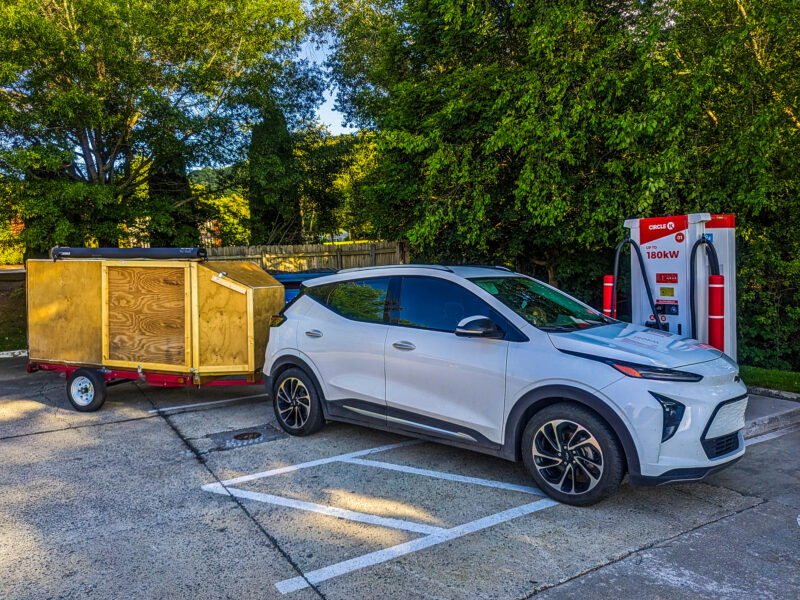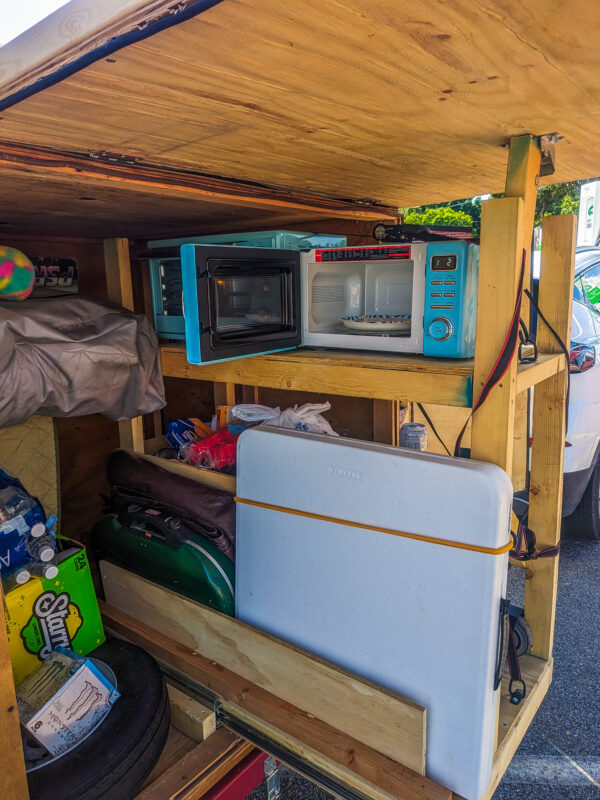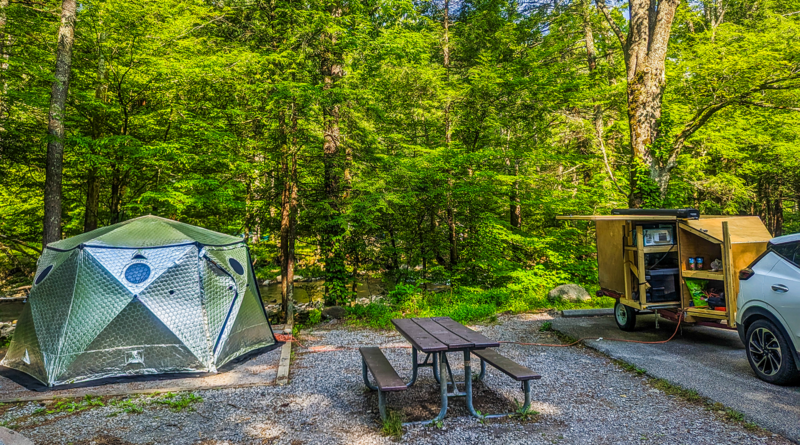Sign up for daily news updates from CleanTechnica on email. Or follow us on Google News!
A few years ago, I got tired of how expensive travel could be. Even with an efficient vehicle, you’re still needing to pay a lot of money for hotels and for meals. Travel with family, and both of those things get even more expensive. What I ultimately want is to pull a travel trailer with an EV, but that’s still out of reach, and probably will be for another couple of years. But, the urge to travel waits for nobody. As John Muir said in a letter to his sister, “The mountains are calling, and I must go.”
But, to do that under electric power, have room for 4-5 people, and keep everyone happy, I couldn’t just pitch a tent and haul some sleeping bags. If I want to spend any serious amount of time in the outdoors and traveling, I also need a comfortable place to work and sleep. So, my setup needed to be a little more elaborate.
Slowly, I gathered up the needed supplies. Some of it, I bought with my own money and with tax return money. Other help came from family. Readers donated to a few fundraisers I ran. Some companies sent outdoor items to review. After gathering up all of the gear, I needed to build a trailer to carry it all with my Bolt, as there’s just not that much cargo room. The end result (so far) is this:
You can learn a lot more about the trailer setup in this article, but in short, it’s a Harbor Freight trailer with a wooden box built on top. Inside, there’s a slide-out kitchen, a box for my Jackery 3000 Pro, a shelf for 1200 watts of solar panels, and plenty of room for Shiftpod shelters, bedding, air mattresses, and even a couple of e-bikes for harsher off-road adventuring!
I took this rig out on a 4,000 mile trip across most of the United States, which was probably stupid in hindsight.
In this article, I want to give a final summary of the trip and share what I learned doing all this towing. For the first leg of the trip, the trailer weighed about 1100 pounds, but on the way back, it weighed in at 1700 pounds. That’s tiny by trailer standards, but for a Bolt, it’s hard work. So, much of what I learned applies to just about any EV one chooses to tow with.
Sure, something like an F-150 Lightning, Cybertruck, or Silverado EV might take a much bigger load to make its range suck, but in the end you’re still dealing with trailering, reduced range, and using the vehicle for power. So, even if you aren’t crazy and want to tow with a Bolt EUV, I hope to still be helpful sharing my findings!
Plan Short Days
The most important thing I learned is that you’re stuck with short days if you’re towing anything over long distances with most EVs. On some days, I had to plan to only drive from about 10 AM to 4 PM, and despite that I still showed up at places around 8 PM. Between family needing to stop, charging taking a few minutes longer than planned, stops at attractions lasting longer than I wanted, and other unplanned things, hours would be added to each day. Given that a Bolt towing spends a lot of time charging (up to half the time if charging stops aren’t spaced well), that means not covering a lot of distance.
I could drive longer days if I planned on stopping at a motel, as they don’t mind if you show up late the way a campsite does. So, on days I could drive for 12 hours, I was able to cover maybe 400-450 miles. My longest day was almost 500 miles, but I showed up at that hotel far later than I’d have liked and didn’t get as much sleep as I needed. So, I ended up needing to re-plan the rest of the trip for shorter days to allow for all of the delays that add up.
This would be better in a vehicle designed for towing, but the same idea applies across the board. Take whatever time trip planning software gives and assume you’re going to spend an extra 3-4 hours for safety.
Don’t Assume Anything About Efficiency Until You’ve Driven Several Hundred Miles
I go into this in far more depth in this article, but I thought based on 40 miles of testing that I’d get around 2.5 miles/kWh towing the trailer. In reality, I ended up getting closer to 1.95 miles/kWh. Considering that many electric pickups get that kind of mileage empty, I’m still doing good, but it meant that my original trip plans went out the window, which sucked.
So, take any new RV or towing setup out on some shorter shakedown cruises before you take a long trip. Figure out what your average efficiency is over hundreds of miles. You’ll have much more realistic expectations with more real-world data. Also, you’ll find out much closer to home if there are problems (I experienced many of them and had to roll with the punches).
Don’t Stop For Only One Night If You Have To Set Up Camp
I’m still eventually going to get a travel trailer that I sleep inside of at some point, because being able to go in and get some sleep would be super nice. For now, though, I’m stuck with unpacking tents, setting them up, and then helping everyone set up the insides of the tents (air mattress, bedding, personal items, lighting, and maybe a heater or small AC). Yes, it’s glamping and not traditional camping.
On this trip, I made several stops where I unpacked the whole campsite in the evening and then packed it all up the next day to leave. This was a dumb choice, as the best parts of the trip ended up feeling rushed and I started every day worn out and sweaty from packing up camp.
So, in the future, I’m not going to unpack camp unless we’re going to stay for 3-4 days. I’m also going to try to use public lands and dispersed camping more so that I don’t need to make a checkout time at an established campground.
Have A Backup Plan and Extra Stuff/Parts
Finally, I’d recommend always having a backup plan. This seems obvious, but many people assume that everything will work fine when it sometimes doesn’t. Tires will wear unexpectedly and/or go flat, so you’d better have a spare or two. Parts might break, so you need to be mentally and financially prepared to get someone to help fix your trailer. Being physically ready for as many things as possible and financially ready for the rest is important.
I’m very glad that I had spare tires, had a floor jack and cross bar, and knew that I needed to get ahold of a welding shop when stuff started breaking. I’m glad I had a multi-tool to disconnect the battery and reset the Bolt’s computer in a pinch. I’m even more glad that I had access to money for an extra night of motel, paying the welder, and buying tires, plus an extra night when a forest fire destroyed the road I was going to take home and took a charger I was going to use offline.
Never Give Up, Never Surrender!
One thing I’m glad I didn’t do was give up when the going got tough a few times. Why? Because I now have a much better trailer that’s ready for more journeys and I’m a lot better at this! This 4,000 mile trip revealed all sorts of weaknesses and deficiencies in my gear and my planning that I had to improvise, adapt to, and overcome.
The journey isn’t over yet, as I still need to make some upgrades, but I’m confident now that I could do the trip again in a few months.
All images by Jennifer Sensiba.
Have a tip for CleanTechnica? Want to advertise? Want to suggest a guest for our CleanTech Talk podcast? Contact us here.
Latest CleanTechnica.TV Videos
[embedded content]
Advertisement
CleanTechnica uses affiliate links. See our policy here.
- SEO Powered Content & PR Distribution. Get Amplified Today.
- PlatoData.Network Vertical Generative Ai. Empower Yourself. Access Here.
- PlatoAiStream. Web3 Intelligence. Knowledge Amplified. Access Here.
- PlatoESG. Carbon, CleanTech, Energy, Environment, Solar, Waste Management. Access Here.
- PlatoHealth. Biotech and Clinical Trials Intelligence. Access Here.
- Source: https://cleantechnica.com/2024/06/22/what-i-learned-towing-4000-miles-with-a-bolt-euv/







